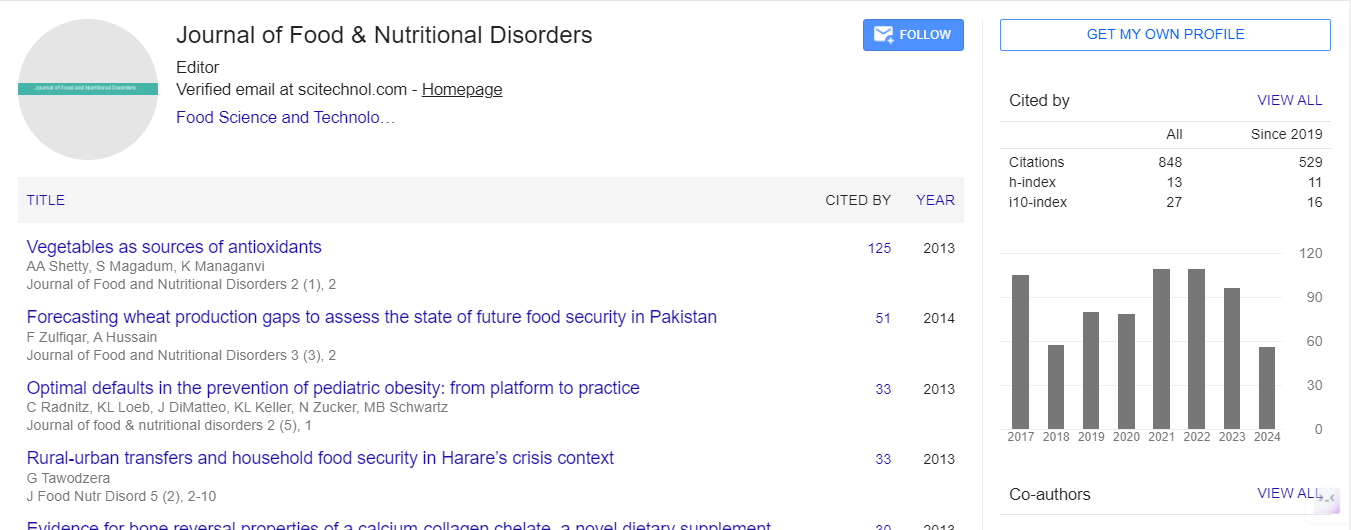Commentary, J Food Nutr Disor Vol: 13 Issue: 5
Gene Therapy Renaissance: Emerging Therapies for Hemoglobinopathies and Beyond
Alan Gonzalez*
1Department of Immunology, University of Barcelona, Barcelona, Spain
*Corresponding Author: Alan Gonzalez,
Department of Immunology, University of
Barcelona, Barcelona, Spain
E-mail: gonzalezalan@outlook.com
Received date: 24 September, 2024, Manuscript No. JFND-24-151327;
Editor assigned date: 26 September, 2024, PreQC No. JFND-24-151327 (PQ);
Reviewed date: 11 October, 2024, QC No. JFND-24-151327;
Revised date: 21 October, 2024, Manuscript No JFND-24-151327 (R);
Published date: 28 October, 2024, DOI: 10.4172/2324-9323.1000429
Citation: Gonzalez A (2024) Gene Therapy Renaissance: Emerging Therapies for Hemoglobinopathies and Beyond. J Food Nutr Disor 13:5.
Description
The field of gene therapy is undergoing a renaissance, particularly in the treatment of hemoglobinopathies like Sickle Cell Disease (SCD) and beta-thalassemia. These inherited disorders, characterized by abnormal hemoglobin production, affect millions of people worldwide and lead to severe health complications, including pain crises, organ damage and reduced life expectancy. In recent years, advancements in gene editing technologies, particularly CRISPR-Cas9 and a deeper understanding of molecular genetics have guided in novel therapeutic strategies that promise to transform the landscape of treatment for these conditions
Hemoglobinopathies arise from mutations in the HBB gene, responsible for encoding the beta-globin subunit of hemoglobin. This results in uneven hemoglobin production and the formation of structurally deficient hemoglobin variants. Traditional management strategies, such as blood transfusions and hydroxyurea therapy, provide symptomatic relief but do not address the underlying genetic defect. Gene therapy offers a potential alternative by aiming to correct or compensate for the defective genes at a molecular level, potentially providing a long-term solution to these debilitating diseases.
One of the most significant advancements in gene therapy is the application of Clustered Regularly Interspaced Palindromic Repeats (CRISPR), a powerful gene-editing tool that allows researchers to precisely modify DNA sequences. This technology has been controlled to directly correct mutations in the HBB gene responsible for SCD and beta-thalassemia. Early clinical trials have shown potential results, with patients experiencing reduced symptoms and improved quality of life after receiving CRISPR-based therapies. For instance, in a groundbreaking trial, a patient with sickle cell disease had their hematopoietic stem cells edited ex vivo and subsequently demonstrated the production of normal hemoglobin posttransplantation. In addition to CRISPR, other innovative therapies are being developed. One notable example is LentiGlobin, a gene therapy that uses lent viral vectors to deliver a functioning copy of the HBB gene to patients' hematopoietic stem cells. Preliminary results have shown that LentiGlobin can lead to substantial and sustained increases in hemoglobin levels in patients with beta-thalassemia, significantly reducing their dependency on blood transfusions. These therapies not only improve patients' health but also have significant implications for their quality of life, allowing greater freedom and less frequent medical intervention.
While the potential of gene therapy for hemoglobinopathies is substantial, it is not without challenges. Ethical considerations surrounding gene editing, including concerns about off-target effects and the long-term consequences of gene modifications, must be carefully navigated. Moreover, accessibility and cost pose significant barriers to widespread implementation, particularly in low-resource settings where hemoglobinopathies are prevalent. Nevertheless, collaborations between academia, industry and regulatory bodies are paving the way for more efficient pathways to bring these therapies to market. The growing body of research and clinical evidence supports the feasibility of gene therapy as a viable option for treating hemoglobinopathies.
The renaissance of gene therapy marks a pivotal moment in the treatment landscape for hemoglobinopathies and beyond. As we continue to unravel the complexities of these genetic disorders and refine our therapeutic approaches, the potential for long-term solutions becomes more attainable. With ongoing research and innovation, gene therapy has the power to significantly alter the prognosis for millions suffering from hemoglobinopathies, offering hope for a future where these conditions can be effectively managed or even cured.
 Spanish
Spanish  Chinese
Chinese  Russian
Russian  German
German  French
French  Japanese
Japanese  Portuguese
Portuguese  Hindi
Hindi 
